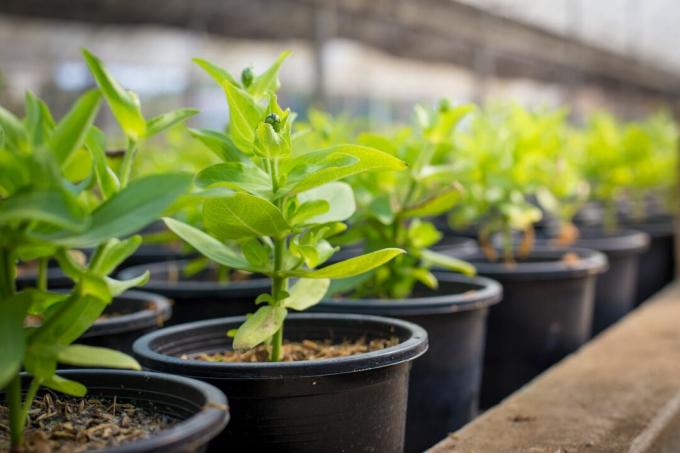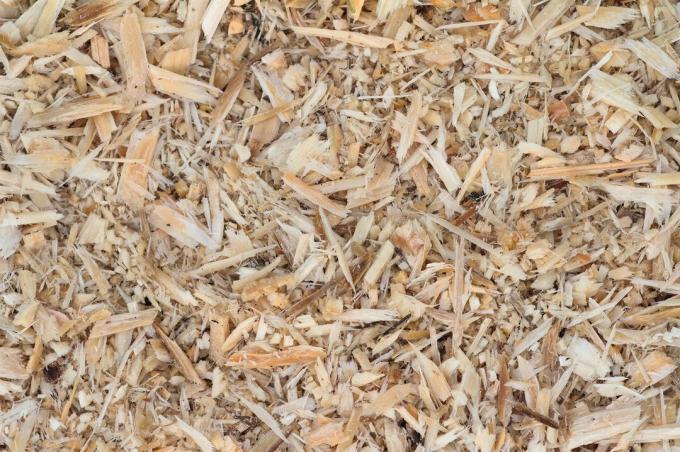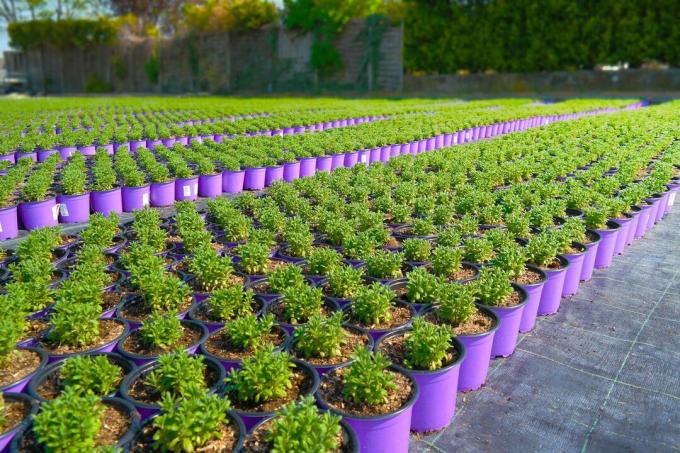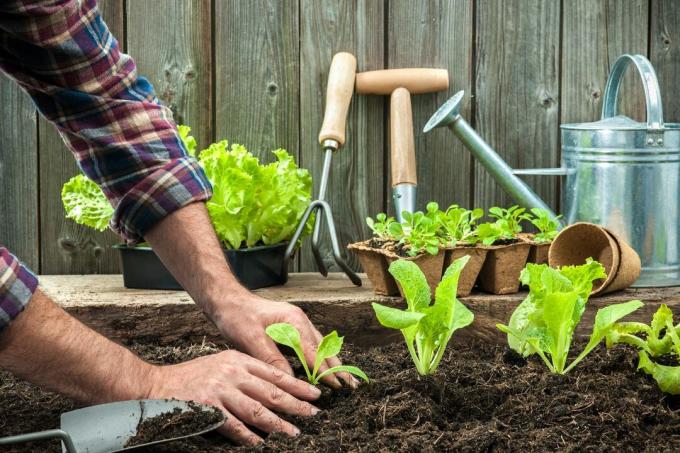Wood fibers are a promising basis for completely peat-free potting soil or can be used as an additive to reduce the peat content to reduce. We will introduce you to the production, properties, use and sustainability of the wood fiber soils.

Peat-free soils such as wood fiber potting soils have become an important sign of responsibility towards our environment. This creates a high pressure to change on horticultural companies, but also the opportunity to recognize the new customer demands as a buying argument.
However, while hobby gardeners and horticultural service providers find it rather easy to switch to peat-free substrates such as wood fiber soils Production nurseries depend on homogeneous and "as usual" controllable substrates, because these form the basis for a (financially) secure and plannable operation. A switch to wood fiber substrate is therefore associated with greater risks for them. It is all the more important to be well informed before switching to peat-free or peat-reduced soils.
"Contents"
- Wood fibre: Peat substitute with extensive experience
-
Wood fiber substrate: production and properties
- Production of wood fiber from wood residues
- Properties of wood fiber
- Use wood fiber substrate
- Can wood fiber substrate replace peat?
- Why is wood fiber substrate sustainable?
- Recommended sources of supply for wood fiber soil
- Contact experts: further information and sources of supply
Tip: Peat-free potting soils did not come along with an increasing understanding of the role of bogs. Even before the "discovery" of peat as a culture substrate, peat-free mixtures were known in which plants could be cultivated without being tied to the soil.

Wood fibre: Peat substitute with extensive experience
The use of wood fiber substrates has been experiencing a clear upward trend for more than three decades. The domestic fiber is increasingly mixed into peat substrates, is the basis for peat-free soils or is even used as the sole substrate in hydroponics.
In addition to the chemical and physical properties favorable for plant growth, the advantage of the softwood fiber used is of course the sustainability of the product. With increasing environmental education (especially among younger generations), the argument of sustainability is becoming a strong selling point. This gives wood fiber potting soil the chance to become part of the unique selling points of sustainable and future-oriented companies.
By the way: In addition to the wood fiber substrates that are already widely used today, compost soils are also a popular alternative to peat, which hobby gardeners in particular like to use. They have a comparatively high weight and their qualities are absolutely satisfactory even for more demanding private gardeners. However, they are not biochemically stable. Despite the use of quality-assured RAL composts, there may be major deviations in the compost properties during transport or cultivation. For example, you can change water and air capacity and nutrient availability. Due to this instability of the properties, compost-based substrates have not been practicable for commercial cultivation up to now.

Wood fiber substrate: production and properties
Wood fiber as a substrate component has been examined by various horticultural institutes and can also be observed in its practical application. The Weihenstephan-Triesdorf University of Applied Sciences and the Industrieverband Garten e. V as well as several state research institutes have compiled extensive information on wood fiber as a substrate component.
Production of wood fiber from wood residues
Chemically untreated coniferous wood is used to produce wood fibers. Many deciduous trees contain too many disruptive secondary plant substances, such as tannins (tannins) and phenols, which can impede plant growth. The starting material is softwood, which is left over from the wood processing industry - for example, wood chips, sawing or planing fractions can be used. Thermophysical digestion or the steam explosion process can be used to extract the loose fibers from the compact cell structures of the plant wood body. In both processes, disruptive resins and tannins are largely broken down. Further treatments are then carried out to optimize pH, wettability, degradability and color in order to facilitate or enhance its use. The color in particular has a great influence on private customers, because they expect a dark color from potting soil.
Due to its high C/N ratio, wood fiber has the negative property of immobilizing nitrogen when it is broken down by microbes. In order to prevent the associated lack of nitrogen in the crop in the substrate, the fibers are treated with slowly released nitrogen. This "impregnation" can also be done with organic nitrogen fertilizers.

Properties of wood fiber
The properties of wood fiber are relatively similar to those of peat, but the water capacity is significantly different. Although the pore volume is very similar to that of peat, the high proportion of coarse pores means that it has a significantly higher air and significantly lower water capacity. The resulting loose structure effectively prevents plant roots from experiencing water stress due to the exclusion of air. However, as with any organic substrate, the loose structure is unfortunately not permanently preserved, but is reduced over time by sagging. The decomposability is very pronounced with wood fiber, but the structural stability can be improved by suitable Improved manufacturing processes or ignored for short culture times of up to five months will.
Due to the thermal pulping process, wood fiber is basically free of weeds and pathogens. At 4.7 to 6.0, the pH value is in a very favorable range for most cultivated plants and is well buffered at the lower end, but hardly at all at the higher end. In addition, wood fiber is basically low in salt and contains hardly any soluble nutrients - apart from potassium, the proportion of which, at up to 100 mg per liter of wood fiber, can be five times as high as in peat.

By the way: The quality of the substrate raw materials should be controlled to ensure homogeneity of the wood fiber soils. The raw materials can be certified with the RAL quality mark.
Use wood fiber substrate
The physical properties of wood fiber and wood fiber substrates enable it to be used, for example, in perennial cultivation outdoors and in container cultivation of trees and shrubs. Wood fiber can also be used for closed culture methods (watering of dams, mats, channels, bag culture). are used, in particular because the high drainage capacity prevents waterlogging and thus many root diseases prevented. Instead, the good air flow promotes healthy root growth.
On the one hand, wood fiber is easily wettable, on the other hand, the surface dries quickly, which prevents the growth of weeds and moss - liverworts included. Even when just mixed into peat substrates, wood fiber improves wettability.
When cultivating, it must be remembered that wood fiber soil requires shorter watering intervals than peat substrate due to its lower water capacity. However, tests were able to show that the loss through transpiration is lower in substrates with wood fibers than in pure peat substrates.
Due to the one-sidedly buffered pH value, caution is required, especially with calcareous irrigation water, in order not to reduce the availability of some trace nutrients, such as iron.
When fertilizing substrates based on wood fiber, it should be noted that the fiber itself contains hardly any nutrients, which means that the basic fertilizer must contain all the essential nutrients. Wood fiber itself only has a minimal ion exchange capacity, which is why suitable mixing partners are essential to avoid excessive salt concentrations on the plant roots. In this context, clay has proven to be a suitable mixing partner, as well as small amounts of quality-assured compost.

| Properties of untreated wood fiber | |
| Density (g TS/l) | 60 – 130 |
| pH (CaCl2) | 4,7 – 6,0 |
| Soluble salts (g/l) | 0,03 – 0,2 |
| Soluble Nutrients | 50 – 100 mg K2O/l |
| N immobilization | Strong |
| decomposability | Strong |
| pore volume | 92 – 96 |
| Air Capacity (Vol%) | 45 – 65 |
| Weed and pathogen stock | Very low |
| wettability | hydrophilic |
(according to: State Research Institute for Horticulture Weihenstephan, Series: Substrate Components, Part 6, April 2008 Edition)
Can wood fiber substrate replace peat?
Wood fiber soils made of high-quality fibers and supplemented with coordinated mixture components can definitely replace peat and contribute to the production of high-quality plants. This applies in particular to gardening and landscaping as well as to private gardeners.
In professional production horticulture, the conversion of culture management, the adjustment of Logistics and marketing requirements for future-oriented investment in wood fiber soils.
Watering intervals and fertilizers change, for long-standing crops it may even be necessary to plan additional repotting. The exchange of experience with similar horticultural companies and substrate manufacturers helps, especially if no literature has yet been published for your own culture. Taspo, colleges and universities with horticultural institutes as well as the state research institutes and Chambers of Agriculture are valuable sources of information that have already been experimenting on a wide variety of crops be able to show. The results of the TeiGa project, which were published freely available, and the growth are particularly valuable various ornamental, vegetable and nursery plants in peat-free, peat-reduced and classic peat substrates to compare.
In addition, before switching to wood fiber substrate, it must be ensured that its suppliers are able to deliver in the long term and with consistent quality. This usually also includes a suitable marketing strategy to make customers aware of the new quality of the product.
By the way: It cannot be ruled out that with adapted culture management even plants of a significantly higher quality can be produced. This is how the Austrian herb and vegetable grower Erwin Seidemann reports, with his completely peat-free mixture to obtain more durable, vigorous and pathogen-free plants, for which he received positive feedback from customers harvest.

Why is wood fiber substrate sustainable?
In a test by the Zurich University of Applied Sciences (ZHAW), the life cycle assessment of various peat substitute products was compared with peat. The following parameters were considered over the entire life cycle of the substrate components:
- contribution to the greenhouse effect
- overall environmental impact
- Cumulative energy expenditure
- freshwater eutrophication
- land use
The life cycle assessment works with a standardized points system that, in addition to the CO2emissions also includes other environmental impacts. Compared to peat, wood fiber scores with just a tenth of the greenhouse gas emissions and the fact that waste is recycled and renewable raw materials used in production.
The Swiss research office Quantis has also carried out a life cycle analysis of peat and other substrate raw materials, but with different parameters:
- contribution to the greenhouse effect
- resource scarcity
- Human health
- ecosystem effect
Here, too, wood fiber was able to score points with a comparatively very low impact on ecosystem quality, human health and the greenhouse effect.
Both studies show that compared to alternatives, wood fiber and wood chips lowest greenhouse gas emissions, the lowest environmental impact and the lowest energy consumption cause. In addition, wood fiber substrate scores well on future availability and potential social risks. Human health and the quality of the ecosystems in which wood fiber grows are also protected.
It should be noted that wood fiber as a substrate component competes with its use as an energy carrier, so that availability and thus price depend on it. It is therefore important to use reliable suppliers when procuring wood fiber substrates.
Tip: The social risks were considered in the above study because some alternatives are caused by pollution of drinking water or the high consumption of resources affect the local population at the mining site be able.
| substrate component | contribution to the greenhouse effect (in kg CO2 equivalents per m3) |
| black peat | 308,0 |
| compost | 277,0 |
| wood fiber | 64,0 |
| bark | 105,0 |
| coconut pulp | 69,5 |
(according to: Quantis Switzerland, Final report for EPAGMA (2012), Comparative life cycle assessment of horticultural growing media based on peat and other growing media constituents, p. 110 – 112)

Recommended sources of supply for wood fiber soil
Neither in the hobby area nor in the case of earth for professional use is there a cross-brand seal of approval or quality that can be used to identify the good functionality or can read the homogeneity across production batches. Each company finds the best source for wood fiber soil individually through exchanges with other companies and substrate manufacturers as well as through its own tests.
The otherwise highly recommended RAL seal of quality checks the weed-free content of soluble Nutrients (in relation to the declared values), the bulk density, the nitrogen immobilisation and some more. However, it makes no statement as to whether the substrate is good or bad for plant culture.
Contact experts: further information and sources of supply
Are you interested in wood fiber or would you like more information and expert recommendations on sources of supply? Send us an inquiry with your contact details and a Plantura expert will get back to you promptly. We're here to help!



